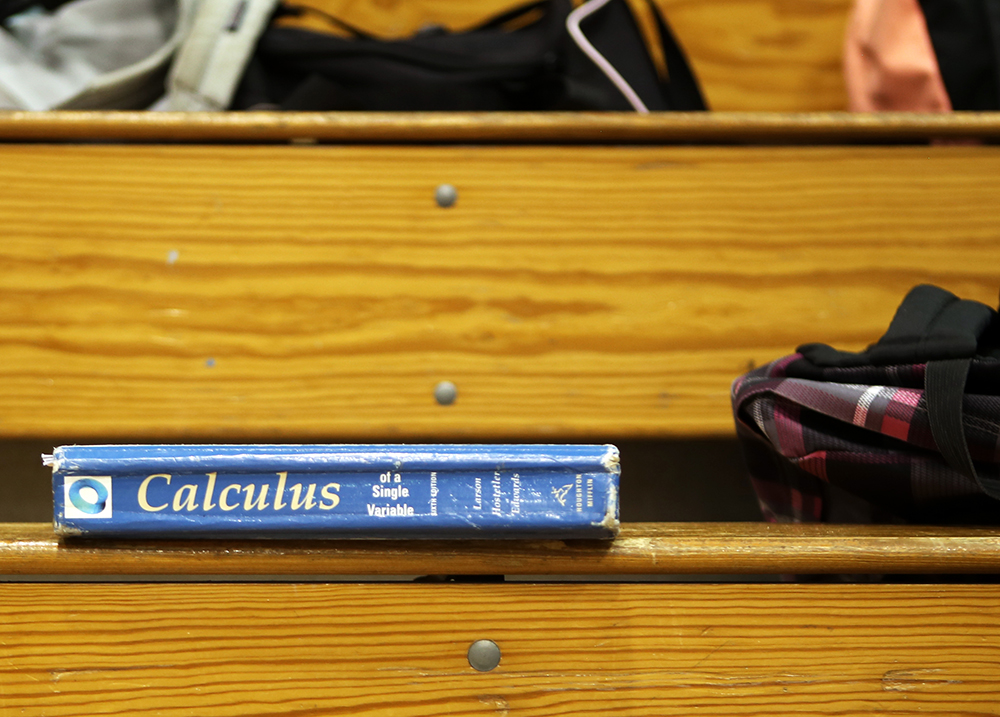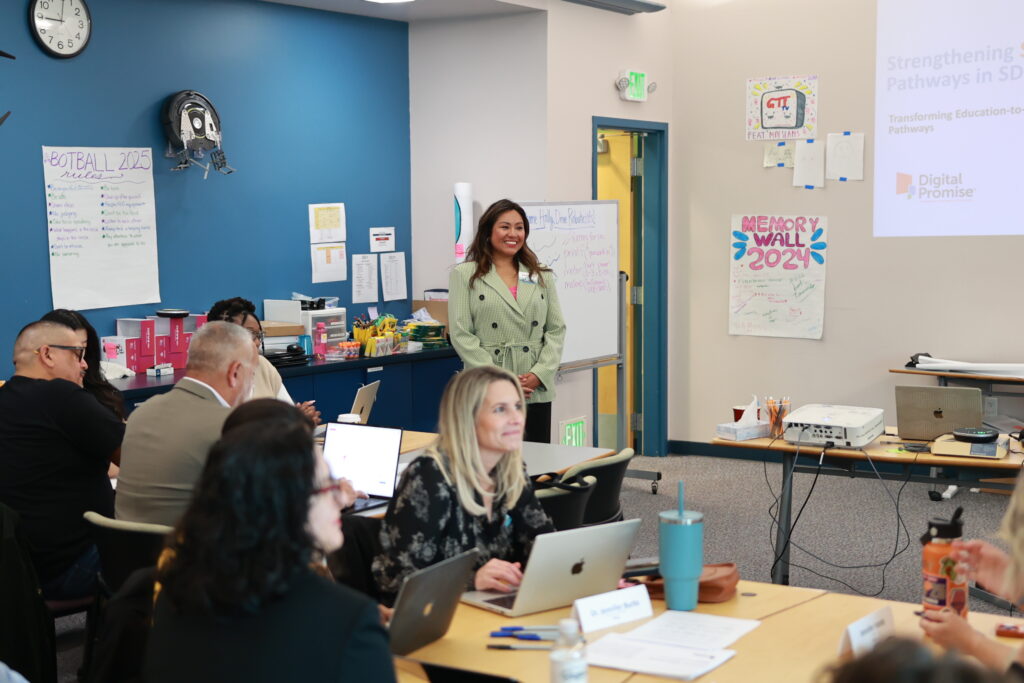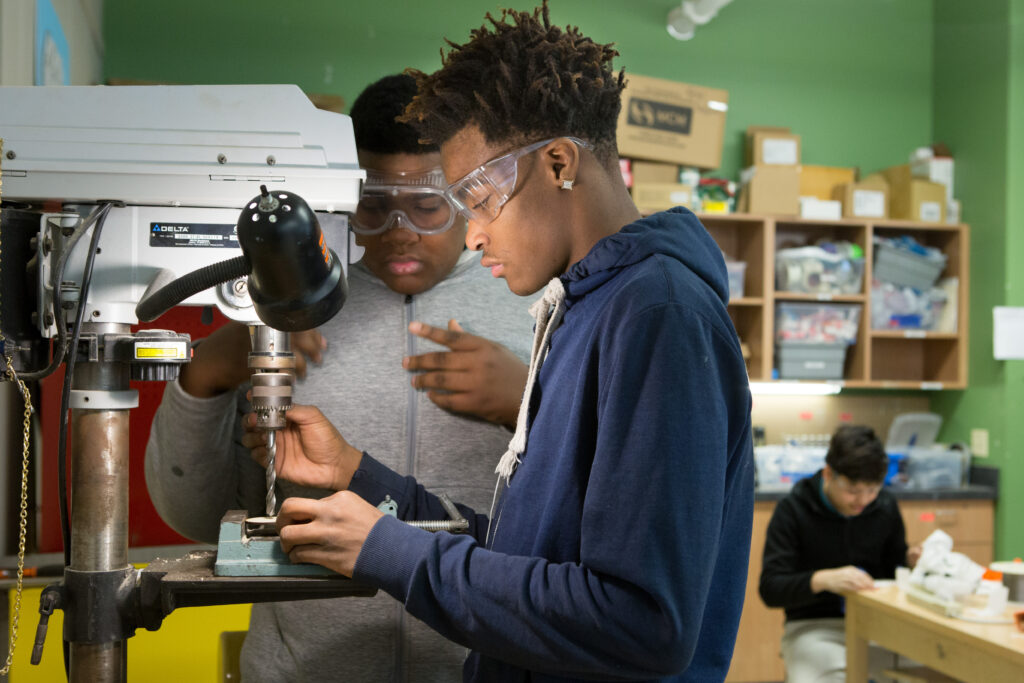
FERMIN LEAL/EDSOURCE TODAY
Este artículo está disponible en Español. Léelo en español.
The guidance for math placement at community colleges has changed since this article was written. For more current information, visit this article.
If you’re a student at one of California’s community colleges and you plan to study a STEM field, you’ll typically have to pass calculus first before diving into many of the other required classes in physics, engineering, computer science, biology or chemistry.
A decade ago, you might have started college by taking algebra, trigonometry or precalculus class — or even a remedial class like prealgebra — before getting to calculus. But a body of research has suggested that having to complete a string of prerequisites before enrolling in calculus wasn’t working for many students and that too many never made it to calculus. That finding was bolstered by evidence showing that Black, Latino and Pell Grant students were overrepresented in community colleges’ remedial courses.
Two recent California laws try to address this problem. Assembly Bill 705 allows most students to skip all sorts of remedial classes in favor of full credit courses that can transfer to a four-year college; AB 1705 additionally requires colleges to place more STEM students directly into calculus rather than lower-level courses like precalculus or trigonometry.
AB 1705 has sparked fervent opposition from some math educators, who worry that less-prepared students who skip traditional prerequisites will fail in calculus and abandon plans to study STEM. They’ve also voiced concern that students who want to take courses like trigonometry and precalculus will no longer be able to do so because the classes will be dropped by colleges.
But defenders say AB 1705, which math departments have until fall 2025 to implement, will prevent students from getting detoured or derailed by long course sequences.
They note that colleges are swapping out the old prerequisite-heavy model of calculus for new calculus courses with extra support for students who need to learn concepts from algebra and trigonometry as they go. Colleges are also investing in tutoring. In addition, colleges have two years to develop revamped precalculus courses.
This guide seeks to answer some of the most common questions about what the law means for STEM students and how colleges plan to implement it.
What’s the problem AB 1705 is trying to solve?
Community colleges regularly used to place students deemed to be underprepared in remedial classes that can’t be transferred to a four-year university. That started to change after AB 705 took effect in 2018. The Public Policy Institute of California found that between fall 2018 and 2022, the share of students starting in transfer-level math rose, as did the percentage of first-time math students completing such a course in one term.
Still, racial equity gaps persisted, with white students completing courses at higher rates than Black and Latino students. Advocates also worried that some community colleges were not implementing AB 705 correctly.
AB 1705 builds on AB 705. As a result of its passage, the state education code now requires U.S. high school graduates to begin community college in courses that meet a requirement of their intended major, though there is an exception if a college can prove a prerequisite course would benefit students. Colleges also have to provide extra help to students who want or need it, such as tutoring or concurrent support courses.
“Students should be aware that they have the right to access calculus and, if they want support while they’re in that course, that they’re entitled to get support,” said Jetaun Stevens, a senior staff attorney at the nonprofit law firm Public Advocates.
What guidance has the California Community Colleges Chancellor’s Office provided colleges on implementing the law?
All STEM students must be given the option to take STEM calculus starting on July 1, 2025, according to California Community Colleges Chancellor’s Office guidance.
Only students who either had a high school GPA of 2.6 or less, or who did not pass high school trigonometry, precalculus or calculus with at least a C have the option to take preparatory courses for calculus. Traditionally, that would include courses like precalculus.
To comply with the law, the chancellor’s office says colleges can drop or redesign existing preparatory courses like precalculus. If they want to continue offering an existing preparatory course, they’ll need to get the chancellor’s office approval. Colleges must show a student is deemed “highly unlikely to succeed” in STEM calculus without the prep course and meet additional criteria.
What’s the evidence in favor of overhauling the traditional STEM math prerequisites?
Supporters of AB 1705 often point to studies that tracked how much better STEM students performed when they enrolled directly in calculus.
RP Group, a nonprofit that conducts research on behalf of the California community college system, reported that students who started in STEM calculus completed the course in two years at higher rates than students who entered a preparatory course for calculus instead and then later tackled calculus, regardless of students’ high school math preparation.
Controlling for multiple factors, RP Group also reported that the probability of completing a first STEM calculus course was lower for students who started in a prerequisite as opposed to students who went straight into calculus.
AB 1705’s proponents also highlight Cuyamaca College as an early adopter. A brief by the California Acceleration Project, one of AB 1705’s backers, reports that 69% of Cuyamaca students who had not studied precalculus and also enrolled in a two-unit support course completed STEM calculus in one term, compared with 30% of students who completed precalculus and then calculus in two terms. Cuyamaca observed improved calculus rates across races; gaps between students of different races were also smaller.
What are math professors’ concerns about AB 1705?
Many math educators said they’re worried about STEM majors with the least math experience — such as students whose highest high school math course was algebra — enrolling directly into calculus. They fear that students will fail those courses at high rates, then drop out of their major or college altogether.
“I feel like the state might just be giving up on those students, to be honest,” Rena Weiss, a math professor at Moorpark College said. “They’re wanting to be a STEM major, and they’re going to get put right into Calculus 1. I just can’t imagine a situation where that student would be successful.”
Professors are also concerned about students who have been out of school for a long time. Students older than the age of traditional college-goers make up a large portion of the students at California’s community colleges.
“To be dropped right into calculus, that’s a pretty significant heavy lift for many of those students,” said Wendy Brill-Wynkoop, president of the Faculty Association of California Community Colleges.
Some faculty members also question the RP Group’s research. Both the statewide Academic Senate for the community college system and the academic senates of at least two colleges — Modesto Junior College and San Joaquin Delta College — have passed resolutions calling for a “comprehensive audit” of the data. The CSU Math Council, a forum for the chairs of the university system’s math and statistics departments, also passed a resolution calling for a peer review of research used to back AB 1705.
Can STEM students still take calculus prerequisite courses before taking calculus?
Yes, in some cases, at least until 2027.
Students at several colleges will have the option to take reshaped, so-called “innovative preparatory courses,” which may include content from college algebra, trigonometry and precalculus.
Since the chancellor’s office has not specified what those preparatory courses should include, there is likely to be a lot of variation across the system. At Modesto Junior College, faculty are developing a class that will include curriculum from all three traditional prerequisite courses, said Tina Akers-Porter, a math professor at the college.
Weiss said Moorpark College’s redesigned precalculus course will follow a flipped model, in which students watch lecture videos and complete exercises at home, apply the material to activities in class and then practice the same concepts again after class. Streamlining is another approach; Ohlone College math professor Andy Bloom said colleagues are removing content from an existing precalculus course that students won’t need for their first calculus class.
Colleges have until July 2027 to test out the newly revamped preparatory courses. Then, the chancellor’s office will assess the courses again to see if they meet student performance benchmarks.
Weiss said she and her colleagues “decided that it was really important to have a precalculus option for students who need it.”
Beyond the new innovative preparatory courses, it’s unclear how many colleges will continue to offer prerequisite calculus classes for STEM majors.
Tim Melvin, a math professor at Santa Rosa Junior College, is hoping that students can still enroll in calculus prerequisites to get more prepared, even if they have to sign a form acknowledging that the courses aren’t required. “We want to give students more options,” he said. “No requirements, but options.”
Brill-Wynkoop said the faculty association is in talks with some legislators and may push for additional legislation that would clarify that colleges can still give STEM majors the option of taking prerequisite classes, without requiring them. The association opposed AB 1705 when it was originally proposed.
Chancellor’s office officials, however, would likely oppose such an effort. John Hetts, an executive vice chancellor for the office, said in an email that arguments in favor of giving students a choice are often used “to persuade students to take a slower path or to allow students to self-select into a slower path,” despite the potential for negative consequences.
What are corequisite courses and how are colleges planning to implement them?
Chancellor’s office guidance now says colleges should offer a corequisite course alongside and linked to the calculus class. The corequisite is an additional course of at most two units designed to integrate topics from areas like algebra and trigonometry into calculus.
The idea is that with extra course time, instructors can see where students are struggling and offer extra help.
Colleges including Chaffey College and Sierra College, for example, now plan to link together corequisite and calculus courses explicitly. Students would sign up for a corequisite scheduled immediately before or after their calculus course. The two courses would feel to students like a longer, continuous course — one that gives their professors time to review or introduce skills students might have missed.
Melvin, at Santa Rosa, said his department is developing a seven-unit calculus class with corequisite support for next fall, which will take up more than half of a given student’s course load.
“But for students that maybe need precalculus and a little algebra help, we definitely think it’s going to be effective,” Melvin said.
How are some early calculus corequisite courses going so far?
There are mixed opinions at colleges that already allow STEM students who have not taken precalculus to enroll in calculus courses with a corequisite.
Southwestern College math professors Kimberly Eclar and Karen Cliffe said that in fall 2023, the campus opened a calculus course with a two-unit support course for students who had not taken precalculus, offering students additional tutoring and non-credit refresher material, too. They were troubled by the results: Of the students who had not taken precalculus, less than 5% passed the class in its first semester.
Some students who do pass calculus without having taken precalculus at college turn out to have learned precalculus while attending high school outside the U.S., Eclar and Cliffe added.
Ohlone College is also allowing students who haven’t taken precalculus to enroll directly in calculus with corequisite courses.
“I’m not seeing this huge underperformance of my students this semester compared to last semester,” said Bloom, who has presented about STEM calculus support at an RP Group conference.
Bloom said that though some students have dropped the course, there are also positive indicators, including that the average score on the first test of the semester exceeded last year’s average.
What other changes are math departments planning alongside AB 1705?
Professors said their campuses are experimenting with technology (like guiding students on how to use AI or using homework software that gauges students’ math skills as they answer questions) and different approaches to testing (like allowing students to retake tests or to choose which questions to answer). Others said they’re aiming to create smaller class sizes, use embedded tutors and tailor calculus courses to meet the needs of life sciences students.















